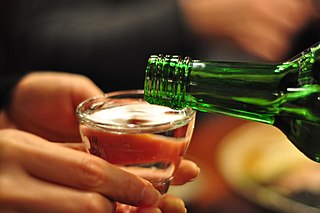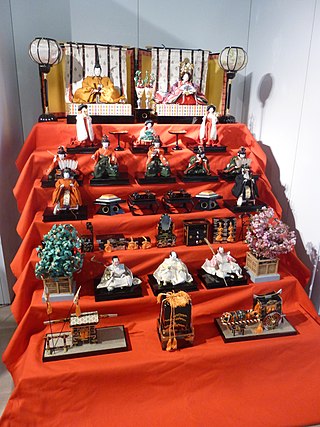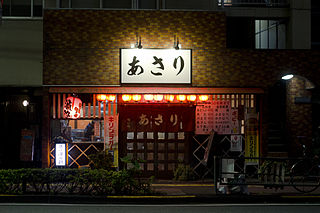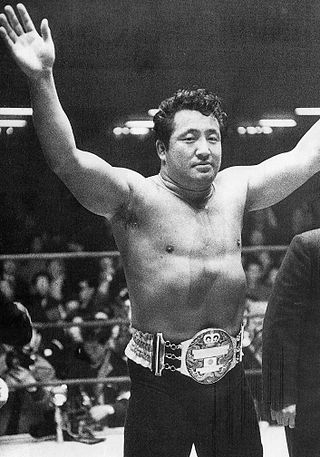World Sake Day, also known as Sake Day, is an annual event held on October 1 as a tribute to sake, an alcoholic beverage of Japanese origin made of fermented rice. [1] The event used to be regarded as only a national event in Japan. [2] October 1 is traditionally the starting date of sake production in the country. [3]

Sake or saké, also referred to as Japanese rice wine, is an alcoholic beverage of Japanese origin made by fermenting rice that has been polished to remove the bran. Despite the name Japanese rice wine, sake, and indeed any East Asian rice wine, is produced by a brewing process more akin to that of beer, where starch is converted into sugars that ferment into alcohol, whereas in wine, alcohol is produced by fermenting sugar that is naturally present in fruit, typically grapes.

Soju is a clear and colorless Korean distilled alcoholic beverage, traditionally made from rice, but later from other grains.It is usually consumed neat. Its alcohol content varies from about 12.9% to 53% alcohol by volume (ABV), although since 2007 low alcohol soju below 20% has become more popular.

Japanese festivals are traditional festive occasions often celebrated with dance and music in Japan. Many festivals have their roots in traditional Chinese festivals, and some ultimately originate in India, but have undergone extensive changes over time to have little resemblance to their original form, despite sharing the same name and date. There are also various local festivals that are mostly unknown outside a given prefecture.

Hinamatsuri, also called Doll's Day or Girls' Day, is a religious (Shinto) holiday in Japan, celebrated on 3 March of each year. Platforms covered with a red carpet–material are used to display a set of ornamental dolls representing the Emperor, Empress, attendants, and musicians in traditional court dress of the Heian period.

The Japanese New Year is an annual festival that takes place in Japan. Since 1873, the official Japanese New Year has been celebrated according to the Gregorian calendar, on January 1 of each year, New Year's Day. Prior to 1872, traditional events of the Japanese New Year were celebrated on the first day of the year on the modern Tenpō calendar, the last official lunisolar calendar.

Mirin is a type of rice wine and a common ingredient in Japanese cooking. It is similar to sake but with a lower alcohol content and higher sugar content. The sugar content is a complex carbohydrate that forms naturally during the fermentation process; no sugars are added. The alcohol content is further lowered when the liquid is heated.

Fukushima Prefecture is a prefecture of Japan located in the Tōhoku region of Honshu. Fukushima Prefecture has a population of 1,771,100 and has a geographic area of 13,783.90 square kilometres (5,321.99 sq mi). Fukushima Prefecture borders Miyagi Prefecture and Yamagata Prefecture to the north, Niigata Prefecture to the west, Gunma Prefecture to the southwest, and Tochigi Prefecture and Ibaraki Prefecture to the south.
Respect for the Aged Day is a public holiday in Japan celebrated annually to honor elderly citizens. It started in 1966 as a national holiday and was held on every September 15. Since 2003, Respect for the Aged Day is held on the third Monday of September due to the Happy Monday System.

Meiji Shrine is a Shinto shrine in Shibuya, Tokyo, that is dedicated to the deified spirits of Emperor Meiji and his wife, Empress Shōken. The shrine does not contain the emperor's grave, which is located at Fushimi-momoyama, south of Kyoto.

Itami is a city located in Hyōgo Prefecture, Japan. As of 1 November 2022, the city had an estimated population of 197,215 in 83,580 households and a population density of 7,900/km2 (20,000/sq mi). The total area of the city is 25.00 square kilometres (9.65 sq mi).

Aki is a city located in Kōchi Prefecture, Japan. As of 31 July 2022, the city had an estimated population of 16,370 in 8076 households and a population density of 52 persons per km2. The total area of the city is 317.21 square kilometres (122.48 sq mi).

Joseph Steven Sakic is a Canadian professional ice hockey executive and former player. He played his entire 21-year National Hockey League (NHL) career, which lasted from 1988 to 2009, with the Quebec Nordiques/Colorado Avalanche franchise. Named captain of the team in 1992, Sakic is regarded as one of the greatest team leaders in league history and was able to consistently motivate his team to play at a winning level. Nicknamed "Burnaby Joe", Sakic was named to play in 13 NHL All-Star Games and selected to the NHL First All-Star Team at centre three times. Sakic led the Avalanche to Stanley Cup titles in 1996 and 2001, earning the most valuable player (MVP) in the 1996 playoffs. In 2001, Sakic earned both the Hart Memorial Trophy and Lester B. Pearson Award as MVP of the NHL. He is one of six players to participate in the first two of the team's Stanley Cup victories and won the Stanley Cup a third time with the Avalanche in 2022 while serving as the team's general manager. Sakic became the third person, after Milt Schmidt and Serge Savard, to win the Stanley Cup with the same franchise as a player and general manager.

An izakaya is a type of informal Japanese bar that serves alcoholic drinks and snacks. Izakaya are casual places for after-work drinking, similar to a pub, a Spanish tapas bar, or an American saloon or tavern.

Nozawaonsen is a village located in Nagano Prefecture, Japan. As of 1 April 2019, the village had an estimated population of 3,653 in 1395 households and a population density of 63 persons per km². The total area of the village is 57.96 square kilometres (22.38 sq mi).

Mitsuhiro Momota, better known as Rikidōzan (力道山), was a Korean-born Japanese wrestler who competed in sumo and professional wrestling. He was known as The Father of Puroresu, and one of the most influential persons in professional wrestling history. Initially, he had moved from his native country Korea to Japan to become a rikishi. He was credited with bringing the sport of professional wrestling to Japan at a time when the Japanese needed a local hero to emulate and was lauded as a national hero. He was inducted into the WWE Hall of Fame in 2017, becoming the first Korean inductee and the third puroresu star to be inducted after Antonio Inoki and Tatsumi Fujinami. He was killed in a street fight with a member of the Sumiyoshi-ikka in 1963.

Tentoku was a Japanese era name after Tenryaku and before Ōwa. This period spanned the years from October 957 through February 961. The reigning emperors was Murakami-tennō (村上天皇).

Sakal is a Marathi-language daily newspaper by Sakal Media Group, its headquarters established in Pune, Maharashtra, India. Sakal is the flagship newspaper of the foundation publication, Sakal Media Group. It ranks among the largest circulated Marathi newspapers.

Niihama is a city located in the eastern part of Ehime Prefecture, Japan. As of 31 July 2022, the city had an estimated population of 115,824 in 57781 households and a population density of 490 persons per km². The total area of the city is 234.50 square kilometres (90.54 sq mi). It has the third largest population in Ehime, behind the prefectural capital of Matsuyama and the recently expanded city of Imabari. It is famous for its Besshi copper mine as well as the annual Niihama Taiko Festival that is the center of annual drunken and boisterous activity and draws tourists from around the country.

International Coffee Day is an occasion that is used to promote and celebrate coffee as a beverage, with events now occurring in places around the world. The first official date was 3 October 2015, as agreed by then International Coffee Organization and was launched in Milan. This day is also used to promote fair trade coffee and to raise awareness for the plight of the coffee growers. On this day, many businesses offer free or discounted cups of coffee. Some businesses share coupons and special deals with their loyal followers via social networking. Some greeting card companies sell International Coffee Day greeting cards as well as free e-cards. Many countries around the world celebrate their own national coffee days at various dates throughout the year. In March 2014, the Member States of the ICO agreed to organise International Coffee Day on 1 October to create a single day of celebration for coffee lovers around the world.

International Workers' Day, also known as Labour Day in some countries and often referred to as May Day, is a celebration of labourers and the working classes that is promoted by the international labour movement and occurs every year on 1 May, or the first Monday in May.